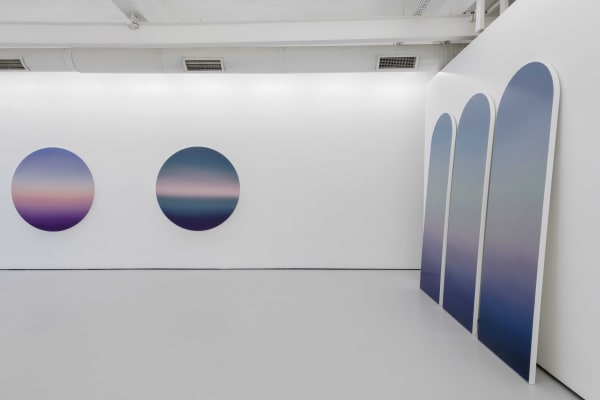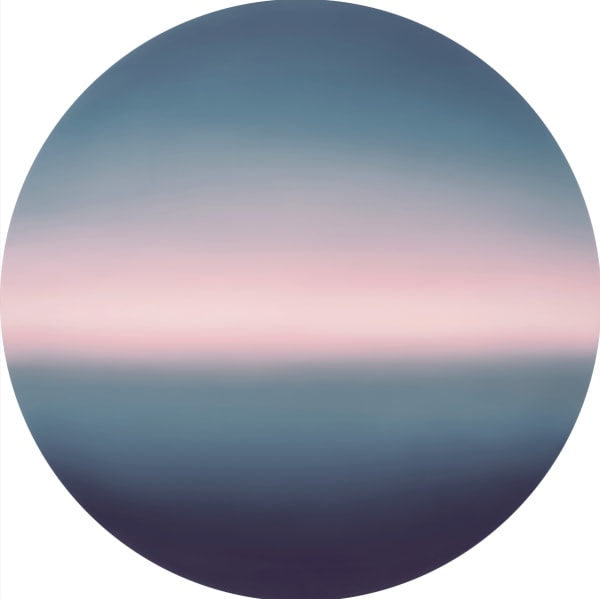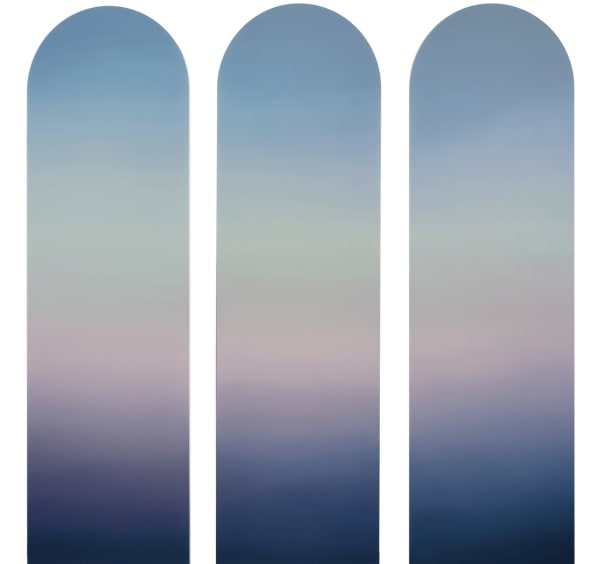Skyscapes: Theo Pinto
THE PILL® is pleased to announce Brooklyn based Brazilian painter Theo Pinto’s first solo show in Istanbul. On this occasion, the exhibition will encompass a body of new Skyscapes of various forms and formats.
Brazilian artist Theo Pinto (b.1990) spent his youth working with different painting techniques in his uncle’s studio, a landscape painter, in Baltimore. After studying art and design at the Maryland Institute College of Arts (MICA) and DIS Copenhagen, the three-dimensional experimental projects Theo Pinto developed as an art director for important brands were awarded in 2018 by One Club of Creativity. His "creative journey", which he has shaped as an independent artist since 2018 with his abstract paintings focusing on the phenomenon of color, has transformed his Brooklyn studio into a kind of "new sensitivities center". By new sensibility I refer to the "form of existence" of an artistic production that emerges beyond aesthetic pursuits in life. Since Theo Pinto sought this form of existence not with his digital, three-dimensional, architecture-like sculpture installations but in the surface of canvas painting, which has a very deep-rooted tradition, he came across Sufism: a journey on which he embarked knowing that this posed a very challenging line of progress. The enlightenment he experienced in the Mevlevi Lodge in Konya in 2019 deeply affected not only his life but also his artistic development, and evolving with different orientations of the Bhakti Movement, Pinto embarked on a process of searching.
The process, which is based on deep-rooted mystical quests and questioning the forms of existence, began with Pinto's work entitled "Second Before Tomorrow," which is the first painting he made in his Brooklyn studio following his return from Konya.
His solo exhibition at THE PILL® has a strong structure that reveals not only the stages he went through during the two-year period, but also the finest nuances of his pictorial cocoon. This cocoon has the courage to confront today's digital visual experiences by entering a dialogue first with the tradition of Color Field Painting started by Mark Rothko, Barnett Newman, Ad Reinhardt, and then Post-Painterly Abstraction shaped by Morris Louis, Frank Stella, and Helen Frankenthaler. While the existential closeness Theo establishes with the phenomenon of Geometric Abstraction constitutes the background of the shaped canvases in the exhibition at THE PILL®, it also leaves the audience in a tete-a-tete with impressive surface interpretations that are not clear at first sight. The impressive atmosphere in these paintings, like a magnet, directs all the sense organs to the light clusters on the canvases. These are composed of tremulous, fragile, barely discernible light vibrations that the audience cannot grasp all at once. In this case, looking at the edges of the canvas becomes quite instructive.
When observed carefully, it becomes clear that in all of Theo Pinto's works, the painting surface is shaped by overlaid thin, permeable layers. The nuances of the color scale formed by the combination of pigments have been mastered in such detail that they do not repeat themselves in any way. While the vibrations of the brush strokes that create the intermediate tones suggest that the artist's hand moves with a certain choreography, the transparent resin layer that constitutes the top layer of the canvas acts like an enigmatic puzzle. The opaque surfaces, on which moving light, color prisms, and reflections are as if fixed forever, are like Theo Pinto's secret signature. The fact that the abstract canvas surface is specially worked on is important because it reveals tones that even the camera's lens cannot perceive.
Since Theo Pinto produces his Skyscapes paintings with the logic of a series, after structuring the bearer material that is at the very background, be it canvas or wood, by superimposing different layers of pigment, he subjects them to a sealing process that will protect them forever under a transparent resin layer that protects them from all kinds of external damage. The permeability of the painting surface, which results from this fixation process performed by the artist with a unique technique, also has a mysterious feature that makes the audience feel as if they are looking at the sky. This aspect of belonging to the sky, is an important starting point for interpreting the pieces in Pinto's Istanbul exhibition.
The architectural installation that the artist has developed site-specifically for the exhibition, makes a reference to the aqueducts that have a significant place in both Byzantine and Ottoman history and especially in the gallery’s neighborhoood. What is interesting is the strong relationship that the temporary walls in the form of aqueducts at the entrance of the exhibition establish with the exhibited canvases that are shaped. We don’t encounter the aqueduct form only in the three large pieces exhibited leaning on the wall. The semicircle forming the top part of the aqueduct makes a direct reference to the artist's Tondo paintings, while the square form on the bottom makes a direct reference to his canvases with the same-sized four sides. This strengthens the mystery on the surface of the paintings, as well as brings forward the "whole-part" relationship in the exhibition that is constructed, leaving no space for coincidence. The presentation of the exhibition, the construction of the temporary walls, deserves special attention since they go beyond being an empty frame for the works and open-up a space for interpreting them. This perhaps could serve as a departure point for interpreting the ambiguity and the abstract approach in Theo Pinto’s paintings. These paintings interpret in various ways the "light-color-form" relationships; and in fact, what is difficult is to interpret the features of these paintings that make a reference to temporary formations (cloud, humidity, rain) observable to the naked eye or via different tools. These works are elaborately created by giving importance to atmospheric phenomena, light prisms, and color particles since the celestial sphere is round; interpreting them based on points in the Spherical Coordinate System used in determining geographical location in the world can help the audience develop a new perspective.
The “celestial effect” of Theo Pinto's paintings is in close relationship with the light experiences we encounter in James Turrel's Skyspace projects. But in the Skyscapes compositions, which reveal visual densities that cannot be seen with the naked eye in the celestial sphere, Theo brings to light emotional intensifications that can be established between the eye and the heart. Since emotion is shaped beyond logic, beyond the causal that is based on the cause-and-effect relationship, it is not possible to measure and interpret it at once.
The existence of a "horizon line," in almost all of Theo's works displayed in the Istanbul exhibition, which can be felt by the watchful eye, is not accidental. This linearity, which makes its presence felt in every work regardless of its form, opens the doors to new visual experiences by arousing a feeling of indeterminacy in the viewer as it adds a new dimension to the horizon. When these are combined with the points that the audience has determined for themselves on earth, they reveal important information about not only the artistic but also the existential characters of the quests in Theo's paintings. Abstract Art, since Kandinsky's theoretical masterpiece titled Über das Gestige in der Kunst, (1911-12) proposes to look at the individual's spiritual perception from a new point of view. With his Skyscapes paintings, Theo Pinto, who follows the path opened by Kandinsky, Rothko, and Turrel, invites the viewer to the emotional intensifications shaped in collaboration by the eye and the heart.
Dr. Necmi Sönmez, Curator — Art Critic
April 2022
Düsseldorf
-

Theo Pinto
Skyscapes
2022
Installation view
-

Theo Pinto
Skyscapes
2022
Installation view
-

Theo Pinto
Skyscapes
2022
Installation view
-

Theo Pinto
Skyscapes
2022
Installation view
-

Theo Pinto
Skyscapes
2022
Installation view
-

Theo Pinto
Skyscapes
2022
Installation view
-

Theo Pinto
Skyscapes
2022
Installation view
-

Theo Pinto
Skyscapes
2022
Installation view
-

Theo Pinto
Skyscapes
2022
Installation view















